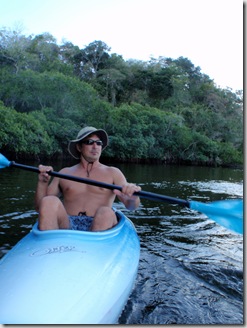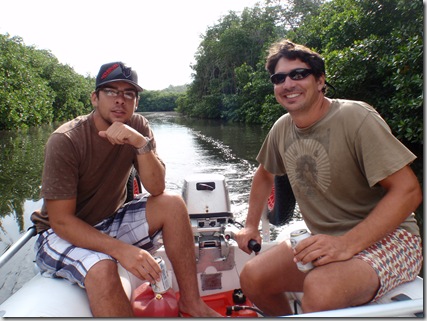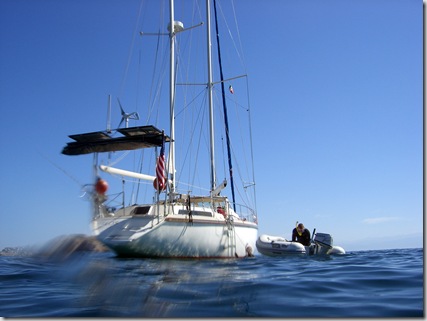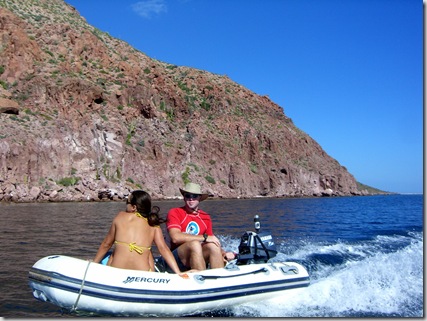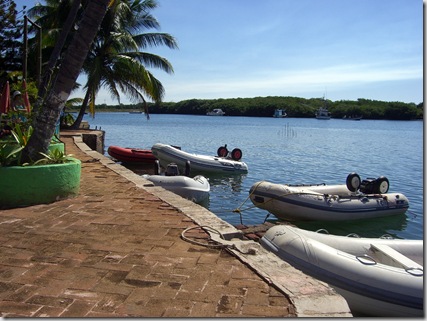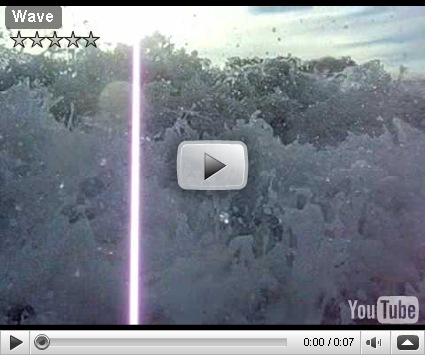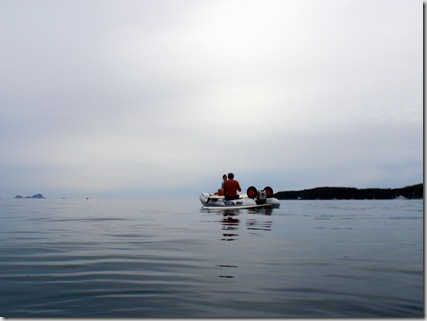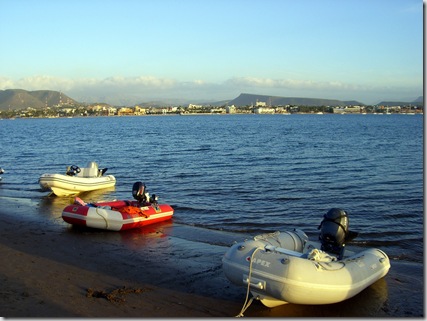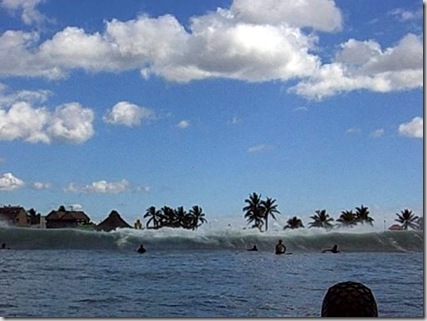A few months before we left Seattle, Stephan, the previous owner of our boat who sailed it nearly around the world, drove down from Bellingham to help us with a few boat projects. Over lunch he told us how important the dinghy is when you’re out cruising. “It’s your car,” he said. “It’s what you carry groceries in, what you travel to shore in… Your life on the boat is dependant on having a reliable dinghy, just like life on land is dependant on having a reliable car.” There’s truth to that. Whether you learn to use it via a New York Drivers Ed course by IMPROV, or by your parents teaching you, having that car is vital.
Before that afternoon, Brian and I never thought of our small inflatable boat as anything more than that. Most sailboats had a dinghy, so we did too. Often we’d leave it tied to the dock when we sailed away for the weekend-we used our kayaks to explore new anchorages, and the dinghy just took up space on deck. Only once did we use our dinghy in place of a car in Seattle: we ferried our laundry to the marina Laundromat, ten docks away, rather than driving it there. And we giggled like schoolgirls the whole way. We felt like renegades as we pulled our bag of dirty clothes from the bottom of a dinghy rather than the trunk of a parked car. A friend did something similar in their lovely new car they recently got thanks to finding a great PCP agreement through a comparison website similar to Money Expert. She said it was exciting!
But we knew all of that would change when we went cruising. So before we left, we sold our land cars and bought our new water car: a nine-foot Rigid Inflatable Boat (RIB) with a hard aluminum bottom and big inflatable tubes on the sides. It doesn’t complain when we drag it onto a rocky beach; it’s light enough for us to lift and carry over sandbars; and it has room to carry the two of us plus a week’s worth of groceries. And like Stephan said, we use our dinghy everyday, just like we used our cars back home.
But what he didn’t mention was something that might have been obvious to him at the time, but was something that I’d overlooked during our conversation: a dinghy is really nothing at all like a car. Sure, you use it as much as a car; you go places in it just like a car… But comparing a dinghy to a car is like comparing a motorcycle to a skateboard. It’ll get you from A to B, but in two very different ways.
Some of the differences are obvious: a dinghy is a boat, there aren’t any tires, and it uses an outboard engine to propel it. But some of the differences aren’t obvious until you use a dinghy day after day.
Here are five reasons why traveling by dinghy is nothing like traveling by car.
1. A dinghy floats. I know I said this one was obvious-a dinghy, after all, is a boat. But the reason I bring this up is because getting in and out of a floating car is much different than getting in and out of a car on land. When it’s tied to the side of the boat we have to climb down a ladder-a six-foot span-to get into it. And in most anchorages the boat is rocking from side to side, and so is the dinghy (usually at a different rate than the boat). So timing our entry from the ladder to the dinghy is crucial to avoid falling directly into the water. It’s also pretty slippery from being outside all night, and sandy and salty from our last trip to shore.
2. A dinghy has no doors or windows to protect us from the elements. We have a pretty powerful outboard-a 15-horsepower Honda, which can propel us through the water at 23 mph. But if there are choppy seas, which there usually are, the dinghy bounces hard and so do we. There are handles to hang onto-like the “Oh Shit” handles in a car, only down next to our legs. These are crucial to help us stay inside the dinghy during rough rides. Also, if it’s raining there’s no roof or windshield to shelter us, and the rain pelts us in the face at 23 mph. We could slow down but then we’d just prolong the painfully rough and wet ride.
3. There are no dinghy parking lots. This one, again, seems obvious. Just like there are no dinghy lanes or dinghy speed limits, there are no dinghy parking lots. Some towns have created pseudo parking lots-the marina in La Paz has a dock where you can tie up your dinghy and leave it there all day, with a security guard watching over it. But most places don’t have dinghy docks, or marinas, and we have to land the dinghy on the beach-most of the time in big, breaking surf.
Our first exposure to the world of beach landings was in San Simeon, California. Our friends on Capaz arrived in the anchorage a few days earlier and watched another cruising boat try to take the dinghy to shore-a shore that any surfer would’ve loved, with big overhead waves. They surfed down a six-foot wave, turned sideways in the barrel, and flipped the dinghy end over end. They returned safely to the boat, but were wet and defeated. The next day Brian and I paddled the kayaks to shore, rather than attempt our first beach landing in those waves. My fate was similar-I rolled over the top of a wave, capsized the kayak, and ended up head first in the sand.
There are some anchorages, though, where the shore is too far to swim or kayak to. When we were anchored in Tenacatita, we took the dinghy to the beach and landed it in gentle surf, no more than a foot high. We were giddy about how easy it was, and anticipated the same size waves when we left. But waves come in sets, and the set that was building was big. We dragged the dinghy from the beach to the water, jumped in as soon as we were thigh-high, and pulled the cord to start the engine. When we turned back toward the waves, we looked up to see a four-foot wave just about to break overhead. A few seconds later we were soaked head to toe, down one pair of sunglasses, and had eight inches of water on the floor of the dinghy.
The next day we took the dinghy to the small village of La Manzanilla. This time before we left the beach, we watched the waves to gauge when the biggest set had passed. After a few minutes it looked like we were in the clear, so we dragged the dinghy from the beach to the water, jumped in as soon as we were thigh-high, and pulled the cord to start the engine. When I turned around I saw a wave building three, four, and then five feet high. “Gun it!” I yelled. Brian turned the engine to full throttle and we sped straight up the face of the wave. Just as the whitewater was beginning to form we launched off the top of the wave, flew ten feet through the air and landed on the backside of the swell.
4. The outboard doesn’t always run and can stop running right in the middle of A and B. I mentioned that we have a powerful outboard to propel us through the water. The problem is that it doesn’t always want to do its job. I’ve nicknamed our outboard Ramon, and Ramon has a disagreeable personality. When we were anchored in La Paz, Ramon decided to take a night off when the current was running 3-knots against us. Brian had to paddle 200 yards to our boat, a feat that took more than 30 minutes.
After we dove with the Sea Lions, just north of La Paz, Ramon quit when we were still a few miles from our anchorage, in the midst of five-foot seas and 20 knots of wind. Brian was able to coax Ramon back to life but it was a tense hour and a half. A few years ago, some fisherman off the coast of Mexico drifted out to sea after their outboard stopped working. Eight months later they made landfall on one of the Marshall Islands-more than 6000 miles away. We always carry paddles with us.
5. A dinghy is fair game on the beach. We’ve heard from cruisers that dinghies and outboard engines are hot commodities down here. We haven’t encountered any thieves, but… When we were anchored in San Blas we landed our dinghy on the beach and returned a few hours later to find three stray dogs peeing on and in and around our dinghy. In Melaque we pulled the dinghy onto the beach and walked a block into town to the nearest bank. A few minutes later we caught two young boys trying to push our dinghy into the pounding surf. Their mom was watching a few yards away, approvingly.
Lately, I’ve been dreaming about cars… Cars with leather bucket seats that you sink down into; cars with power windows that keep the rain out and air conditioning in; cars with windshields, cars with tires, cars with trunks, cars with backseats. My friend from Kansas has recently purchased a brand new Wichita Buick Enclave. There’s something quite special about driving a new vehicle for the first time that just can’t compare isn’t there?
But, then again, in a car, you don’t feel the wind on your face when you drive down the road; you’re inside even when it’s beautiful outside; you can’t commute on the water; and you have to deal with traffic, stoplights, speed limits and road safety. A small accident on the road can end up with you spending hours researching lawyers just so you know your options, whereas in the water it’s much easier to stay safe and away from others. And maybe the biggest reason of all; you can’t anchor a car just outside the surf break and paddle into the line-up.
It might be rough and wet, but I guess I won’t trade-in my dinghy for a car anytime soon. For now, I’ll just hang on and enjoy the ride.


